Brazil Vacation: Experience Sugarloaf Mountain Rock Climbing
Climb To The Top Of Rio De Janeiro's Mountain Landscape
By Robert Schrader | Published on July 25, 2022
Have you always dreamed of a Sugarloaf Mountain rock climbing adventure? You're not alone. It's difficult to deny how iconic Rio de Janeiro's celebrated crag is. The Pão de Açucar, as it's known in Portuguese, is a sweet sight no matter where in Rio you happen to be. It's visible while you swim at Copacabana Beach and still imposing even as you stand beneath Christ the Redeemer atop Corcovado Mountain.
Everyone can recognize and appreciate Sugarloaf, but not everyone understands why it's so important or all the many ways you can incorporate it into your Rio de Janeiro itinerary. If you haven't booked your cruise vacation trip to Brazil, this guide may make that decision for you.

Fast Facts About Sugarloaf Mountain
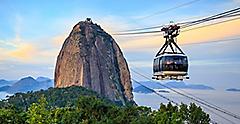
As you plan your Brazil vacation, learning the dimension of Sugarloaf Mountain is probably not high on your list of priorities. Though many vacation travelers find the details fascinating. For example, at 391 meters or 1,282 feet, the Sugarloaf is just over half as tall as Corcovado, the mountain where the Christ the Redeemer statue stands. This is obvious when looking down on Sugarloaf from up there, but might not be apparent from Copacabana Beach, where the two peaks can seem of similar height to one another.
The name of the mountain, as sweet a sight as it is, also puzzles many bound for Brazil. This makes sense, since those without a background in agriculture probably won't be able to see the resemblance. It got its name in the 16th century, when Portuguese colonial businessmen named it after the country's most profitable industry: sugar cane cultivation. The mountain closely resembled the loaf-like shape of refined sugar, which was a hot trade commodity at the time.
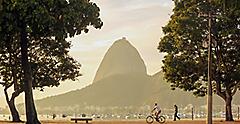
Rio's Original Icon
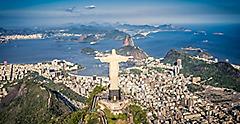
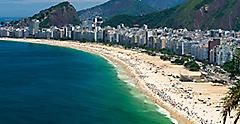
When your Brazil vacation takes you to Rio de Janeiro, you'll notice that Sugarloaf is prominent in most restaurants and souvenir shops, adorning the walls in photographs, and representing Rio on postcards. It's much more ubiquitous than its man-made competitor. You might even perceive this as you explore the historic Santa Teresa neighborhood or sunbathe on Copacabana Beach. While you can see Christ the Redeemer if you're looking for it, Sugarloaf Mountain practically commands your attention.
Once you ride the funicular to the top of Corcovado for a closer look at the statue — and finish taking your obligatory arms-outstretched selfie — the focal point of the "money shot" you'll snap of Rio's cityscape will undoubtedly be Sugarloaf Mountain. It manages both to dominate and dwarf everything else around it while tying the entire scene together. Its ever-present status is intriguing, and one of the best ways to see it in all its glory is a with a Sugarloaf Mountain hike.
Can You Climb Sugarloaf Mountain?
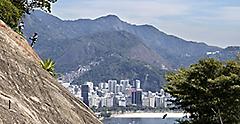
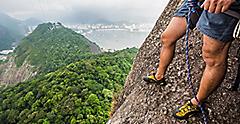
The specifics of your adventure will vary depending on the tour experience you book, but they tend to follow the same trajectory. First, you'll hike a relatively easy and flat trail most of the way up the mountain, then once the landscape becomes a bit more rugged and vertical, you'll gear up. Using ropes and pulleys, you'll climb the last 65 feet to the very top. As a result, your work results in an immediate reward: sweeping views of the gorgeous city of Rio de Janeiro.
The vantage point from the top of Sugarloaf Mountain can't be beat. On one side, you can see straight across the water to Niterói. From this view, try and spot the iconic, surrealistic art museum designed by famous Brazilian architect Oscar Niemeyer. On the other side, you'll see Copacabana Beach, and in the far distance, Corcovado and Christ the Redeemer stand tall.
After getting your fill of photos and videos, remember to take a few breaths and have a moment of stillness just for yourself. Then, it's time to head back down. The great news is that while you can technically go down the same way you came up (and many thrill-seeking adrenaline junkies do), most tours have a one-way cable car ticket priced in, so you can sit back, relax and relish in what you just achieved.
Don't Forget About Urca
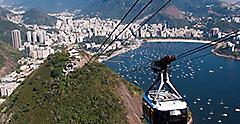

Beyond the bright, pastel colors of many of its buildings, what's immediately striking about Urca is the fact that it's primarily composed of single-family homes — as opposed to the multi-story hotels and residential buildings that predominate in Copacabana, Ipanema and Leblon. At the time of its construction, it housed ordinary families who relocated from elsewhere in Rio to the then-new neighborhood. These days, with land and space at a premium, Urca is one of the wealthiest areas of Rio de Janeiro.
That being said, it's not expensive to enjoy Urca. For every high-end, luxury boutique, there's a shop selling something affordable and accessible, like Brazil's best-selling Havaianas flip-flops. Likewise, while Cantina do Jorge is so exclusive that only residents of the blocks around it can enjoy a meal there, nearby Urca Grill is as easy to access as the sea breeze effortlessly flowing through its open-air dining room. There's no better way to celebrate a successful Sugarloaf Mountain rock climbing excursion than with a cold beer and a big meal of Brazil's best comfort food.
If the view of the beaches from the top of Sugarloaf made you crave a sun-soaked beach day, walk around the base of the mountain to secluded Praia do Forte, which is smaller than the more popular Rio beaches and also much quieter. And if the rampart of the Fortaleza de São João piqued your interest, keep in mind that you typically need an advance booking to tour it.






